
There is no shortcut to creativity. There are no auto modes on your camera that give you artistic control. You can’t want to be an artist yet not want manual control of your camera. You need one to accomplish the other. You have to make a choice in the beginning of this journey. Do you want to be an artist with your camera, or do you just want to take pretty pictures?

Creating an intentional blur, such as the one illustrated here, is a gamble. Society expects an image to be in focus. Straying from that path by using extremely shallow depths of field or, as was the case in this image, a multiple exposure is dangerous. Artists must make a choice when they create an image. Do they take the expected route or run the risk of condemnation and produce an image that more resembles who they are and how they feel?
There are only two things a person can do with a camera in hand: record and create. Most people choose to record what’s in front of them, documenting the way something looks instead of sharing with others how it makes them feel. Ironically, these same photographers emulate, revere, and idolize those artists who choose to create instead. They buy the same gear and use the same computer programs, hoping that some day they too can “take” the same type of photographs. The intention is noble, but the plan is flawed. Artists take risks, not just pictures. Their messages have no more to do with what type camera they use than the color of the socks they wear. Success doesn’t come from blind imitation. It is born in the heart, nurtured by the spirit, and grows from a willingness to create something unique. The truth (as all of us, honestly, already know) is that artists don’t just take pictures of things, they communicate a feeling. They share a little piece of themselves with the world and aren’t afraid of the criticism that may follow.
Vision is key. You must see something in your mind’s eye before you shoot it. You must imagine the possibilities because you understand the options, then just go for it. This is not the same thing as pointing your camera at something and taking a pretty picture. The goals of a typical photographer are quite different from those of an artist, and their approaches differ dramatically. An artist uses his understanding of his equipment to capture an image that shows the world in a new way, not the way that it appears at first glance. He visualizes a possibility then creates a unique image. He exploits his experience, not just his equipment. He uses what he knows, what he expects. He sees what others can’t or won’t.
A blank canvas, some paints, and a brush—nothing is as intimidating or as freeing. Limitless possibilities sit in front of the artist. There is an unending canvas of creativity just waiting for his hand, ideas, and message. While this proves intimidating to most, a painter simply smiles. He begins with his background, visualizing an end result and then builds his way up, adding layer upon layer of colors, tones, shapes, and patterns until what he saw in his mind’s eye comes to fruition.
It’s a difficult process, and mastering it will take time, but the results can be spectacular. Artists challenge society; they push their vision past the obvious and take us on that journey with them. Painters make us hold our breath. They lead us to another reality splashed with colors, textures, and tones drawn from their imagination, using tools we all can wield.
The question for photographers is, What if we were to take a more artistic approach to our own image-making process? What if we applied the same artistic “painting” style with our tools? What if, instead of starting with our subjects, we began with the background and slowly added graphic elements with intent and purpose? What would happen?
Most photographers (admittedly) sketch with their cameras. They worry about their subject first and allow the other pieces to lie where they are—eliminating, blurring, or masking them later in a computer. But what if we took a more proactive approach? Wouldn’t the image itself seem more controlled, a bit more polished? What happens to our own vision once we see what is truly possible? How far can we grow as artists if we give up the pursuit of just being a photographer? Great photography is truly about possibilities, not just subjects or gear.
It’s not about what paints you have, it’s how you use them. We in-focus artists take a different route than most when we use our cameras. Ours is a truly painted vision. We begin with our background (like any good artist), making it the best it can be with whatever tools we have. We then slowly add graphic element after element until a real piece of art emerges, something that can only be visualized by a person who sees beyond what’s in front of him. We let the world of lines, shapes, patterns, colors, and tones fall over us like a blanket, allowing us to look beyond “normal” vision and see what is really there.
A Walk-Through. We take photographs of the things in the world that entice us. We sometimes like to think it’s our gear that makes it possible, but it comes from the heart. Take, for instance, a simple image of flamingoes—something anyone with any camera could capture. There is nothing wrong with the image. It is what it is—a simple representation of what was before the photographer. It’s hard to pass by without taking a photo; it’s not called a “flamboyance” of flamingoes for nothing. But what if we approached the scene differently and took an artistic approach? What if we used the patterns the flamingoes create and their color—the things that drew us in? What if we built an image using the flamingoes as our background instead of our subject? What if our message, not just the stuff we shot, was flamboyant?
It’s not about shooting a simple picture of what’s in front of you, it’s about creating a dramatic illustration of how this stuff makes you feel. You can express yourself with your camera. You can see beyond your own vision, but it will take willpower to make it happen.
We begin with the background, the single most overlooked graphic element in photography. The background is the root system from which everything else grows.
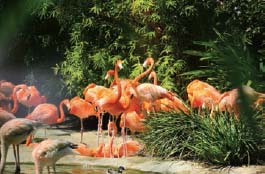
Here, we’ve changed shooting positions and placed a few graphic elements (weeds, twigs, and flowers) in front of the flamingoes. The shallow depth of field blurs these elements, making them unrecognizable.
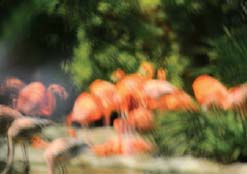
In this shot, you can see a bit of spatial distortion occurring as we move our focus point closer to the lens. The magic starts to show when we “give up” our subject.
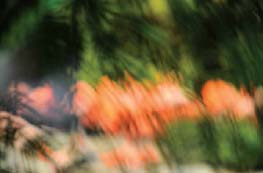
As we push the focus point even farther from the flamingos, the spatial distortion intensifies. The image is starting to look like a painting.
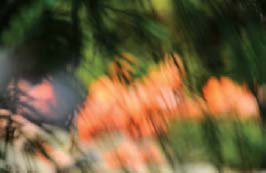
Even the slightest change of focus position or subject location alters the look of the lens aberrations, making the paint strokes appear elongated and introducing a more dramatic rhythm to the image.

As we move our focus point farther from the flamingoes, the identity of the next tier of graphic information comes into focus.
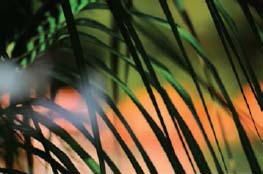
Here, the focus point has shifted to a closer tier of graphic information (a plant). Notice how the pink flamingoes are no longer flamingoes—they’re just shapes and colors. There is yet another graphic tier beginning to show itself in the left-hand side of the image—the white blur.
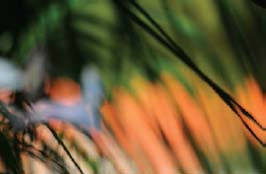
Pulling the focus point back toward the white blur reveals additional shapes and more tiers of graphic information. Note that the spatial distortions (the paint strokes) begin again with the green weeds.
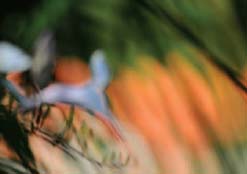
Moving the focus point closer to the camera shows the outline of even more useful shapes. The green weeds are combining with the flamingoes to create a beautiful painted background.
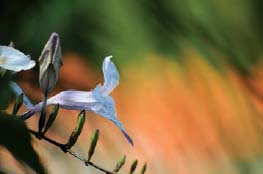
Moving the focus point a bit farther back reveals the flower itself. Combined with our new (and utterly amazing) painted background (composed of bright green weeds and colorful pink flamingoes), we achieve an image that no one can see, let alone take a picture of.
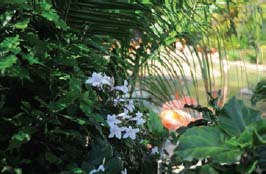
This is what the scene looked like to the naked eye. Very few people would have lined up the six graphic tiers of information to create the image. They would have had to give up on the obvious subjects in front of them (the flamingoes) and would have had to know that when compressed (blurred) background and foreground elements are united, they can create some spectacular effects.
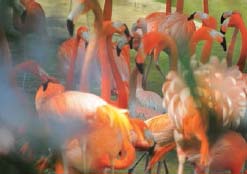
Change positions and you can create a new reality. Here, we moved slightly and the flamingoes moved greatly. We again started with our background “color.”
We begin by refocusing the lens (moving the focus point closer to the camera ), and the painted strokes begin to appear.
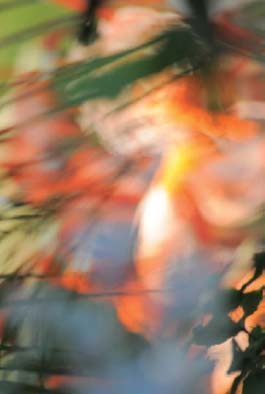
Since the background will simply be a painted tapestry of color, why not rotate the image 90 degrees after we take the shot? After all, we are no longer shooting flamingoes, so the eventual orientation of the image doesn’t matter.
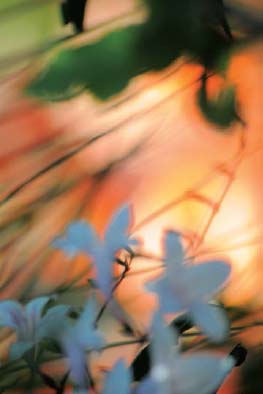
Moving the focus point back a little farther reveals the flowers. Note that this time, they appear dark. This can easily be remedied with the addition of light from an off-camera flash.
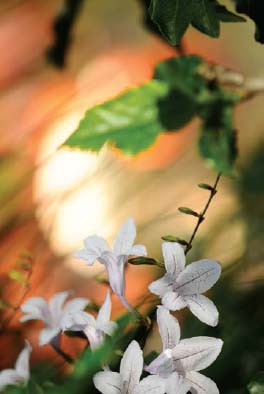
With the extra light from the flash, the focus becomes rock solid and the separation between graphic elements becomes even more apparent. The image is really beginning to take flight.

Here again is how the scene appeared. The flash has been introduced to add needed light. Positioned off-camera, the flash produces flattering and natural-looking shadows. It is simply handheld and pointed at the flowers (the power settings and angle of coverage settings were adjusted to taste).
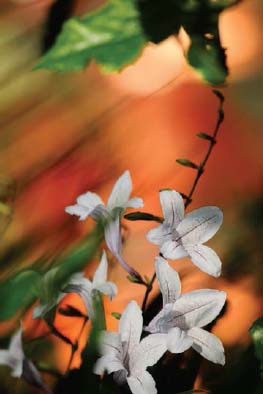
To create this image, we set high contrast and saturation settings in the camera. Compare this image to the first one in the series, which was made with low contrast and saturation settings. The first image appears more passive. Remember, as an artist, you can dial in how something makes you feel. Photography is not just about how something looks.
The Peacock Effect. The flamingoes in the previous example would be a tough subject for most photographers to move past. We’ve been conditioned as a society to see and then photograph bright, colorful subjects. Robin has a name for this universal preoccupation with startling objects: she calls it the “peacock effect.” Like a moth to a flame, we zero-in on what we think our subjects should be, ignoring the other possibilities around us.
This explains, in part, why the majority of photographers today chase lenses and camera bodies. They need to get the best-possible photo of that peacock and will do anything to make it happen. When their quest fails (as it often does), they resort to “fixing” their image in the computer—adjusting its color, saturation, and white balance to make it look more creative. The sad part is, that’s not being creative at all. Manipulation is not art (it’s not even real photography). Creativity happens at the moment of creation. It’s the result of moving beyond what society sees and expects—it’s not the result of taking a lackluster image and pumping it up in your computer.
Robin offers a solution that will help you move past the peacock shot: “Take the peacock picture first,” she says. “Get it out of your system. Then look closely at what the peacock is made of. If its colors and shapes would make a great blurred background, then blur them and use them that way. Use your longer lenses and compress that blur. Get closer to your foreground elements and use a larger aperture to further intensify the blur. Then move forward and backward slightly and use the power of perspective to make that blur whatever size you want it to be. Work hard and concentrate on your new vision. Start seeing your ‘subjects’ as backgrounds, then find something to put in front of it. I promise your world and your view of photography will change forever.”
That’s good stuff!
The number of real artists with cameras is dwindling. Our dependence (as a society) on auto settings and downright fear of manual control see to this. Worse yet is the fact that the better auto features become, the less reason we have to push our skill level and vision. The less we push, the less we think and understand. The basics are being forgotten and, once gone, true expression with a camera will die. This is why we must take a stand. We must show the world that there is another option, another reason to use the camera. Artists have voices. It’s time we used them.
Think for a moment about what we tell our kids. We ask them to play with their guitar, to play the piano, to play with their crayons, hoping that one day they’ll appreciate the tool and become an artist with it. Yet, what are the first words out of our mouths when it comes to photography? “Don’t play with that camera, it’s not a toy.” We have put the camera and its associated gear on a pedestal, forgetting that it’s just a box with a hole in it—a rather impressive calculator that just happens to capture light.
While photography today isn’t complicated, learning to do something well with our cameras is. Real photography—true expressionism with a camera—isn’t about just one thing, it’s many things to many people. It’s as much about inner reflection as it is about a portrait session, a wedding gig, an office party, or even a paycheck. Although many photographers rely on and tout the use of auto systems, some of us enjoy the challenge of doing things ourselves. We don’t need to make every image perfect. We revel in the pride that comes from heartfelt workmanship, of knowing what to expect when we use certain settings and using that knowledge to create something special. The above image is a wonderful example of this. It appears the way it does because the photographer knew how and why to choose various internal camera settings. It was envisioned first, and then shot in camera, in monochrome. The simple fact is, the image was shot because of how it would look in black & white. It wasn’t an afterthought; it was the only reason the photographer pulled off to the side of the road. If you are not inspired by what could be, then, believe us, you won’t take the picture. And, the last time we checked, it’s really hard to “fix” or modify an image if you never shot it in the first place.
Worse yet, after more than twenty-five years of autofocus and autoexposure, most people have forgotten the basics of photography. They have forgotten what it means to create, express, and take on a challenge. They strive for acceptance, anonymity, and normalcy, hoping to simply take an average picture. Few take the risks necessary to grow.
Letting go of societal norms is tough for many. Taking a blurry photo such as this one may not seem right, but this type of image (an abstract) is a valid choice for an artist—and it’s one that shouldn’t be overlooked. If you were to shoot just like everyone else, getting the same light, the same focus, the same color, where would that leave creativity or individual pride?
Our goals have softened as much as our resolve. Today, it’s all about “fixing” images after the fact, trying to make other people like them, hoping to attain the glazed-over ideal of a perfect image. Editing programs are touted more than individual skill. Depth of field control is as foreign to most new photographers as composition. How can all of this be right? What does it do to our view of photography, and where does it lead us? Some actually think that the auto modes on a camera can help them be more creative, that they can alleviate the “burden” of having to choose the amount of light they capture or what will be in focus. This is just wrong. If those things weren’t that important, then why do so many professionals spend countless hours fixing them after the fact? Those creative options make up the heart and soul of every message we create. An artist can’t give up control over those options. We need to stop being afraid of making mistakes and use them to gain experience. We have to have faith in ourselves and what we’re capable of. We can all do this. We can bring real art back to photography, but we’ve got a long road ahead.

You don’t see the guitar player complaining that it’s too hard to play certain notes and that his clients should give him a pass and not worry about it. If he’s not comfortable with a live performance, if he doesn’t think he’s ready, then he doesn’t do it. A skilled musician treats his art with respect. He dedicates himself to it.
If you were to hire a photographer and a musician for the evening (let’s say for a wedding), you would probably do a bit of research first, listen to online samples, check out galleries, ask for references, and (hopefully) hire the best, right? Now, let’s say both show up at the event. The musician opens up his case and pulls out a child’s guitar with two buttons—one labeled jazz, the other rock. He stands there, smiles, and starts playing. Would that upset you? Of course it would. You hired an artist, someone whom you expect to be in something other than auto mode. Yet would you (even for a second) check to see if your photographer were shooting in auto? No, you wouldn’t. And if he was, would it bother you? No, probably not.
There are thousands of visual possibilities and options that surround you each and every day. The world can and will look different than it appears before you now. An artist challenges himself to not only be aware of these alternate realities but to learn the physics and mechanics needed to capture/create them. He pushes himself to the next level by learning and understanding not just the basic compositional elements that make up every image but also how and why people react to certain visual stimuli. In turn, he uses that information to make his message even more pronounced. While the in-camera “painting” technique used to create this image was fairly simple (the swipe, described in chapter 6), the reasoning behind its use was a bit more complex. Rhythm is a huge piece of the graphic puzzle. It’s something the mind wants to see, as it helps with closure and creates a very loose type of balance. A painting technique was used to create this image, which depicts this type of rhythm. It’s not just about a flower or a technique. It’s about the meaning and purpose of art.
On some gut level, we have given up our reverence for art with a camera. It’s no longer about the artist and what he’s capable of, it’s just about the pictures he takes. It’s not about his ability to express or create. We just want someone with better equipment than we have to shoot the wedding. And what of the “professionals” who follow suit? They no longer push themselves. For them, it’s a job. They have a list of shots to capture, and since no one is asking for the “good” stuff, they don’t bother to create them. They take the simple shots, fix them in postproduction, and collect the check.
What kind of example is this? What does this mean to our children, to the next generation of photographers? A musician doesn’t show up at a venue, play his guitar in a vacant room, edit his music on a computer, then come out and play the recording only when he thinks it’s perfect. He does it live. He has pride. Sure, he makes some mistakes, but his art shines through. He has experience. He uses his failures to firm his resolve. He has skill and he’s paid the price to garner it: hours upon hours of practice each day until his fingers bled. Can you, as a photographer, say the same thing? Have you put in the same amount of effort? Can you honestly say that you’ve developed the callouses a guitar player has, that you’ve learned to stretch your fingers as he, until you know for a fact what will come out of your camera before you take the shot? Seriously, would you call a guitar player who uses auto modes a musician, or would you call him a cheat? Be careful of your answer, it will define you.
The Opposition. Many professionals today would argue that it’s impossible to be that good, to dial in all those settings while shooting an event such as this, that they have other (more important) things to worry about. We disagree. Practice makes perfect, and there is nothing more important to a photographer than capturing the perfect amount of light, of being creative or speaking from your heart. The real point is that you’re losing your creative edge by shooting in auto mode. If you give up on developing and perfecting real skill, then you give up on any chance of growth. If you’re not in charge of the options your camera affords, then you’ll lose sight of them. You won’t know what can truly happen. You won’t have a clue.
If that didn’t sell you on the idea, how about this? True artists are commissioned. Photographers are hired. Who do you think gets paid more, a disc jockey who simply plays songs from an iPod or a musician or band? An artist is brought in because of his own unique vision and because of what he can produce—the art that comes from his soul. A photographer is there to shoot things. Sure, the world needs both, but who do you think is going to make more money? Who do you think will make a name for himself, be more respected, be more in demand? And who will change the world itself, setting the example and leading others to real art?
An artist with a camera relies on the knowledge and experience gained from his failures and his attempts to correct them. He knows and believes that success without failure is meaningless. He loves a challenge, enjoys failing, and learns from every step. He keeps things in perspective and doesn’t fall prey to physical or mechanical shortcuts that hinder his learning.
To do this well, to become an artist with a camera, you will need to return to some traditional values, such as hard work, dedication, and a willingness to learn from your mistakes. You have to begin to see the world as a set of options instead of subjects, to see possibilities instead of mountains, to see light instead of people. And, as you’ll soon learn, this has very little to do with the equipment you use. It’s an inward journey that allows you to explore who you are and how you see the world. The camera just captures that vision, nothing more.
Difficult? Yes. Impossible? No, not by a long shot.
Each person is challenged by full manual control and artistic visualization in a different way. Many struggle with the technical side, while others find the abandonment of their own preconceived notions intolerable. No matter your challenge, make it a point of pride to keep moving forward. Make a commitment to yourself to realize your creative goals.
Here are some important and attainable goals to keep in mind as you undertake this journey:
While true art with a camera can be accomplished with any gear, there are few pieces that will prove useful as you learn the techniques.
Lens Recommendations. Often the power of compression will play a key role in your ability to blur foreground and background elements. Many of the techniques in this book require that type of control. Longer focal length lenses (anything between 85mm and 200mm) will help you attain shallow depth of field. Lenses that afford larger aperture settings (such as f/1.8 and f/2.8) will also prove useful, though they are not required. Good painted images can be created with any lens, but some make it easier than others.
Photography is truly about expression. We can use the tool to share our innermost thoughts. When I was young, I was deathly afraid of clowns. Although this fear has subsided with age (thank goodness), I can still explore this memory and these feelings with my camera and flash. In this image, we’ve connected the dots between the artist I am today and the child I was then.
Filter Options. When painting with a lens, you’ll often want to cut the amount of ambient light. Slower shutter speed techniques such as the flutter and swipe require it (these techniques are addressed in chapter 6). To that end, you’ll need a few pieces of extra gear. Neutral density filters have long been a photographer’s best friend when it comes to cutting ambient light. These can get expensive and require quite a bit of space in your camera bag. A variable neutral density filter is a perfect solution. When the filter is rotated, the photographer can dial-in the exact amount of darkness he wants to add to his image. This is a very expensive option. Fortunately, there is a more economical and classic alternative: by simply “crossing” two linear polarizers you can mimic the same effect. To do this, place one linear polarizer on top of another on your lens. Rotate the bottom polarizer to eliminate glare and turn the top filter to eliminate ambient light. Voila—instant variable neutral density filter. (Note that circular polarizers cannot be crossed.)
Not all linear polarizers are made the same. Some have a creative “breaking point”; depending on the manufacturer, you may find that crossing polarizers does little more than put a shadow across your image. Some brands work only at 80 percent, while others give it their all. Some allow you to strip every bit of ambient light without consequence, while others create a drastic shift in color. If you already own a few linear polarizers, test them out. Take some slow-shutter-speed images and see what happens. If your current gear isn’t up to task, it may be time to consider a few more accessories.
We make it a point to highlight new artistic techniques, showing how anyone with any lens can create art with their camera. To see more of this style of photography or pick up a few artistic insights, please follow us (and our students) on Facebook at www.facebook.com/iflcsandiego or visit our web site at www.iflcsandiego.com.
Being creative means being comfortable with your gear. Spend as much time as needed on the basics. Learn to control depth of field, exposure, and glare. Discover the action-freezing power of fast shutter speeds and the creative power of slower ones. Join a photo club, enlist the aid of family or friends—do whatever it takes to garner the experience you need to become an artist with a camera.